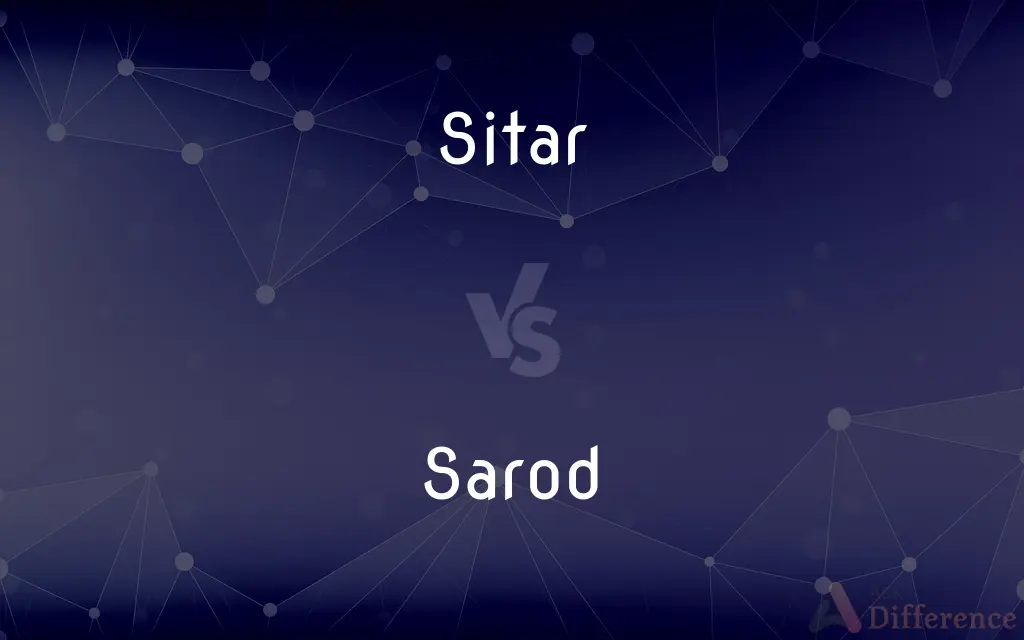Sitar vs. Sarod — What's the Difference?
By Fiza Rafique & Urooj Arif — Updated on April 25, 2024
The sitar features long, sweeping strings and a gourd resonator, primarily used in Hindustani classical music, while the sarod is fretless, offering a smoother sound, and also vital in Hindustani music.

Difference Between Sitar and Sarod
Table of Contents
ADVERTISEMENT
Key Differences
The sitar is a plucked stringed instrument, famous for its deep, resonant sound, characterized by its complex string arrangement that includes both played and sympathetic strings. In contrast, the sarod is also a stringed instrument but is fretless, allowing for a wide range of subtle variations in pitch and a fluid, melodic output.
Sitar strings are played with a mizrab (plectrum), and its body typically includes a main resonator at one end, usually made of a gourd, which enhances its distinctive, reverberating sound. The sarod, on the other hand, is played with the fingernails or fingertips, and its body, commonly made of wood and without a main gourd resonator, produces a somewhat softer and less resonant tone.
The design of the sitar includes a long, hollow neck with adjustable frets that accommodate the intricate melodic patterns typical of Indian classical music. Meanwhile, the sarod's fretless fingerboard allows for the expression of microtonal nuances, making it particularly effective for delivering the sliding notes essential to Indian music.
The sitar often supports long, intricate raga performances, allowing for extensive improvisation and complex rhythmic cycles. Conversely, the sarod, while also used for raga, tends to emphasize rhythm and pace, facilitating rapid, fluid passages that are bright and assertive.
Typically, the sitar has a more ornate appearance, often decorated with intricate carvings and inlays. The sarod is usually more austere in design, reflecting its focus on functionality and sound purity over visual aesthetics.
ADVERTISEMENT
Comparison Chart
Strings
Many, including sympathetic strings
Fewer, no sympathetic strings
Fretted/Fretless
Fretted
Fretless
Playing Technique
Played with a mizrab (plectrum)
Played with the fingernails or fingertips
Body Resonator
Usually has a gourd resonator
Typically wood, no gourd resonator
Sound
Deep, resonant, capable of complex overtones
Smooth, subtle variations, less resonant
Compare with Definitions
Sitar
A classical Indian stringed instrument with sympathetic strings.
Ravi Shankar popularized the sitar globally with his performances.
Sarod
Design focuses on sound purity, often less ornate than sitar.
The sarod's simple design belies its musical versatility.
Sitar
Played with a mizrab, allowing intricate plucking patterns.
She practiced her scales on the sitar using a new mizrab.
Sarod
Played using the fingernails or fingertips for smoother slides.
Playing the sarod well requires precise finger techniques.
Sitar
Often heavily decorated with inlays and carvings.
His sitar was ornately decorated, reflecting traditional craftsmanship.
Sarod
Lacks a gourd resonator, typically made of wood.
The wooden body of the sarod contributes to its distinctive timbre.
Sitar
Has a long, fretted neck facilitating complex music pieces.
The complex ragas on the sitar require mastery over its fretted neck.
Sarod
A fretless Indian stringed instrument known for fluid sounds.
His sarod recital captured the nuances of the raga perfectly.
Sitar
Features a gourd resonator for deep, reverberating sounds.
The sitar's gourd resonator enhances its rich tones.
Sarod
Supports fast, rhythmic, and melodic passages effectively.
The sarod is excellent for executing fast and rhythmic compositions.
Sitar
The sitar (English: or ; IAST: sitāra) is a plucked stringed instrument, originating from the Indian subcontinent, used in Hindustani classical music. The instrument was invented in medieval India and flourished in the 16th and 17th centuries and arrived at its present form in 18th-century India.
Sarod
The sarod is a stringed instrument, used mainly in Hindustani music on the Indian subcontinent. Along with the sitar, it is among the most popular and prominent instruments.
Sitar
A stringed instrument of India having a seasoned gourd for a body and a hollow wooden neck with movable raised frets. Stretched over the frets are usually 6 or 7 metal strings on which the melody is played with a pick, and stretched under the frets are 11 or more sympathetic resonating strings.
Sarod
A lutelike stringed instrument of northern India having a fretless fingerboard and usually 17 to 19 strings, including drone and sympathetic strings, played with a plectrum.
Sitar
(musical instruments) A Hindustani/Indian classical stringed instrument, typically having a gourd as its resonating chamber.
Sarod
(musical instruments) A fretless string instrument used mainly in Indian classical music.
Sitar
A stringed instrument of India; has a long neck and movable frets; has 6 or 7 metal strings for playing and usually 13 resonating strings
Common Curiosities
What types of music are best suited for the sarod?
The sarod is also used in Hindustani classical music and is particularly effective for playing expressive and fast-moving passages that benefit from its smooth, sliding notes.
What is the learning curve like for the sitar compared to the sarod?
Learning the sitar can be challenging due to its numerous strings and frets, which require mastery of complex finger techniques, whereas the sarod, being fretless, demands precision in finger placement and control over microtonal shifts.
How are the strings on the sitar tuned?
The sitar's strings are tuned to the notes of a particular raga, with the main strings tuned for melody and the sympathetic strings tuned to resonate harmonically.
What types of music are best suited for the sitar?
The sitar excels in Hindustani classical music, particularly in the intricate and slow-building raga performances that showcase its resonant sound and elaborate ornamentation.
What materials are used to make a sarod?
Sarods are usually made from a combination of wood and metal, with the fingerboard often being covered in steel to facilitate smooth sliding of the fingers.
How do performers sit while playing the sitar?
Sitar players usually sit cross-legged on the floor, with the sitar's neck tilted slightly upwards and the resonator resting on the player’s lower left foot.
What materials are used to make a sitar?
Sitars are typically made from teak or tun wood for the neck and gourd for the resonator, with metal frets and strings.
How is the sound of the sarod different without sympathetic strings?
Without sympathetic strings, the sarod produces a cleaner, more focused sound that emphasizes the melodic line and the subtleties of the player's finger movements.
What is the historical origin of the sarod?
The sarod also has its roots in ancient Indian music but was significantly developed in the 19th century, influenced by similar instruments from Afghanistan and Persia.
How are the strings on the sarod tuned?
Sarod strings are also tuned according to the raga being performed, but with fewer strings, the tuning process is generally less complex than on the sitar.
Can the sitar and sarod be used in ensemble performances?
Yes, both instruments are often used in ensemble settings, complementing each other and other classical Indian instruments in larger musical compositions.
What is the historical origin of the sitar?
The sitar originated in the Indian subcontinent around the Middle Ages, evolving from Persian lutes and influenced by the music traditions of the Mughals.
How do performers sit while playing the sarod?
Like sitar players, sarod players sit on the floor cross-legged, but the sarod is held more horizontally, resting on the player’s lap.
What role do the sympathetic strings on the sitar play?
The sympathetic strings on the sitar vibrate in response to the main strings, enriching the music with a complex, resonant backdrop.
Are there any famous musicians known for playing the sitar?
Ravi Shankar is perhaps the most famous sitar player globally, known for his profound impact on both Indian and Western music.
Are there any famous musicians known for playing the sarod?
Amjad Ali Khan is a renowned sarod maestro who has gained international acclaim for his virtuosic performances and contributions to Indian classical music.
Share Your Discovery

Previous Comparison
Just vs. Merciful
Next Comparison
While vs. MeanwhileAuthor Spotlight
Written by
Fiza RafiqueFiza Rafique is a skilled content writer at AskDifference.com, where she meticulously refines and enhances written pieces. Drawing from her vast editorial expertise, Fiza ensures clarity, accuracy, and precision in every article. Passionate about language, she continually seeks to elevate the quality of content for readers worldwide.
Co-written by
Urooj ArifUrooj is a skilled content writer at Ask Difference, known for her exceptional ability to simplify complex topics into engaging and informative content. With a passion for research and a flair for clear, concise writing, she consistently delivers articles that resonate with our diverse audience.
















































